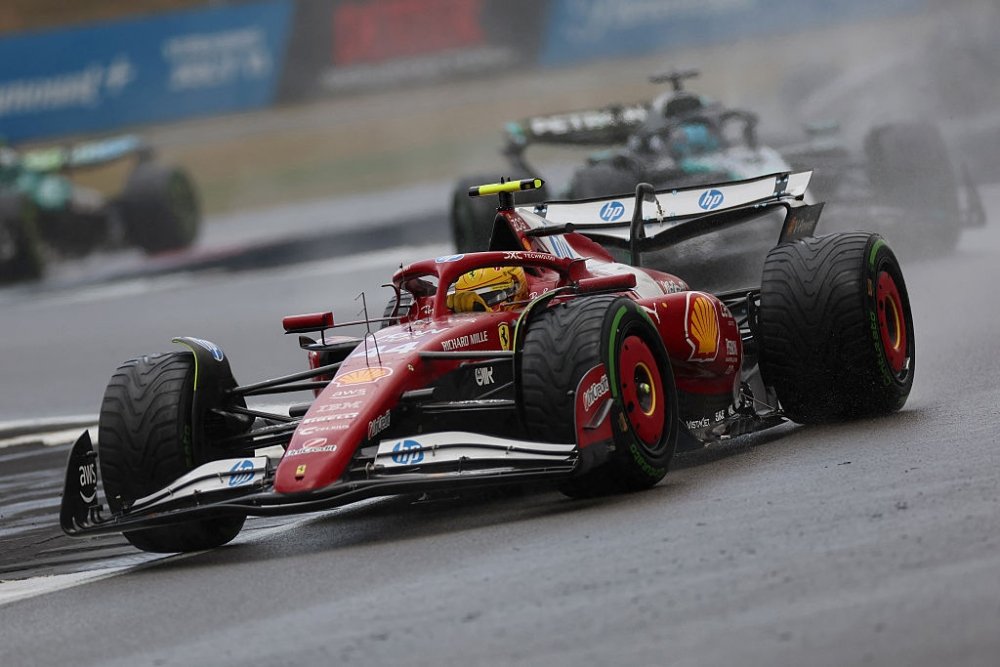The Challenges of Wet Weather Racing: Insights from Lewis Hamilton and Ferrari’s Strategy
Lewis Hamilton recently shared his thoughts on the challenges he faced while driving in wet conditions during the British Grand Prix at Silverstone. He described this year’s Ferrari as the most challenging car he has ever driven in the rain, especially after finishing in fourth place. The anticipation was high for Ferrari going into the qualifying rounds, given their strong performance in dry conditions during both low and high fuel sessions. However, the team faced disappointment as they concluded qualifying with Hamilton in fifth place and his teammate Charles Leclerc in sixth.
A Rainy Race Day at Silverstone
The unpredictable weather conditions during the race presented a unique opportunity for drivers to make up ground. Hamilton initially applied pressure on Lando Norris, who ultimately claimed victory. However, as the race progressed, Hamilton struggled to maintain his pace and lost ground to Nico Hulkenberg in the later stages of the event.
Reflecting on the race, Hamilton commented, “It was a difficult day for everyone. While it wasn’t the result I was hoping for, I still managed to score some points. This car was the hardest to handle in these conditions.” His remarks highlight the intricacies and challenges of racing in wet weather, especially with a car that does not perform well under those circumstances.
The Difficulty of Driving in Wet Conditions
Hamilton’s experience on the track revealed the extent of the challenges posed by the wet weather. He emphasized that he was initially putting pressure on Norris, particularly at Turn 15, but soon found himself unable to keep pace. The tires lost grip significantly, making the car difficult to control. Hamilton expressed the frustration of not being able to maintain the competitive edge he hoped for, saying, “The car was unbelievably tricky to drive.”
The challenges of wet racing are multifaceted. Drivers often have to make split-second decisions about their driving style, tire management, and race strategy. Hamilton, in his second experience driving this car in wet conditions, acknowledged the steep learning curve. “I can’t even express how challenging it is to drive this car in the rain,” he noted, emphasizing the need for data collection and analysis for future improvements.
Ferrari’s Strategy Under Scrutiny
Ferrari’s performance during the British Grand Prix was not solely attributed to the car’s handling. Team principal Fred Vasseur also pointed out the complexities involved in making strategic decisions during a race, especially when faced with changing weather conditions. He admitted that the team did not execute their strategy flawlessly, which further complicated their race performance.
Vasseur reflected on the timing of their pit stops, stating, “In hindsight, it was probably one lap too early to switch to slick tires.” He acknowledged that Hamilton lost significant time in the early laps when conditions were still challenging. The decisions made by the team on the pit wall are critical, and Vasseur emphasized the difficulty of anticipating the right moment to make such calls.
Anticipating Weather Changes
The dynamic nature of racing conditions means teams must remain agile and ready to adapt. Vasseur explained that if teams wait too long to make a decision, they risk falling behind as other drivers capitalize on better conditions. “It’s easy to say after the race that a pit stop should have been made earlier or later,” he added. “But during the race, you need to make quick decisions based on the information available.”
Additionally, Vasseur highlighted a significant challenge the team faced: the loss of GPS data for Hamilton during the race. This lack of critical information meant they were operating without a complete understanding of Hamilton’s performance on the track. “We were completely blind, and that made our decision-making even more complicated,” he admitted.
The Importance of Data and Collaboration
Hamilton’s comments about the need for data collection underscore the importance of collaboration between drivers and engineers. As he noted, it is crucial to take the lessons learned from challenging races and apply them to future car designs. “Having lots of data from this race is essential for discussions with the design team for next year’s car,” he explained.
The relationship between drivers and their teams is vital in motorsport. Engineers rely on feedback from drivers to fine-tune the car’s setup and performance. In Hamilton’s case, he noted that elements of the current car could inform improvements for future designs, ensuring that the team continues to evolve and adapt.
The Competitive Landscape of Formula 1
The British Grand Prix showcased not only the challenges faced by Ferrari and Hamilton but also the competitive landscape of Formula 1. As teams adjust to evolving conditions, the race for points becomes even more intense. The unpredictability of weather can level the playing field, allowing for surprising outcomes and shifts in rankings.
Hamilton’s competitive spirit remained evident despite the challenges he faced during the race. He acknowledged that while the outcome was not ideal, the experience provided valuable insights. “I learned a lot today,” he reflected, recognizing that every race is an opportunity for growth and development.
Conclusion: Future Implications for Ferrari and Hamilton
The experiences of Hamilton and Ferrari during the British Grand Prix serve as a reminder of the complexities involved in Formula 1 racing. From the challenges of driving in wet conditions to the intricacies of strategic decision-making, each race presents unique hurdles that teams must navigate.
As the season continues, the lessons learned from this race will undoubtedly influence Ferrari’s approach moving forward. With a focus on improving car performance and refining strategies, the team aims to enhance its competitiveness in future races.
The journey of Hamilton and Ferrari reflects the broader narrative of resilience and adaptation within the world of motorsport. As they face the challenges ahead, the insights gained from their experiences will be pivotal in shaping their future success on the track.
